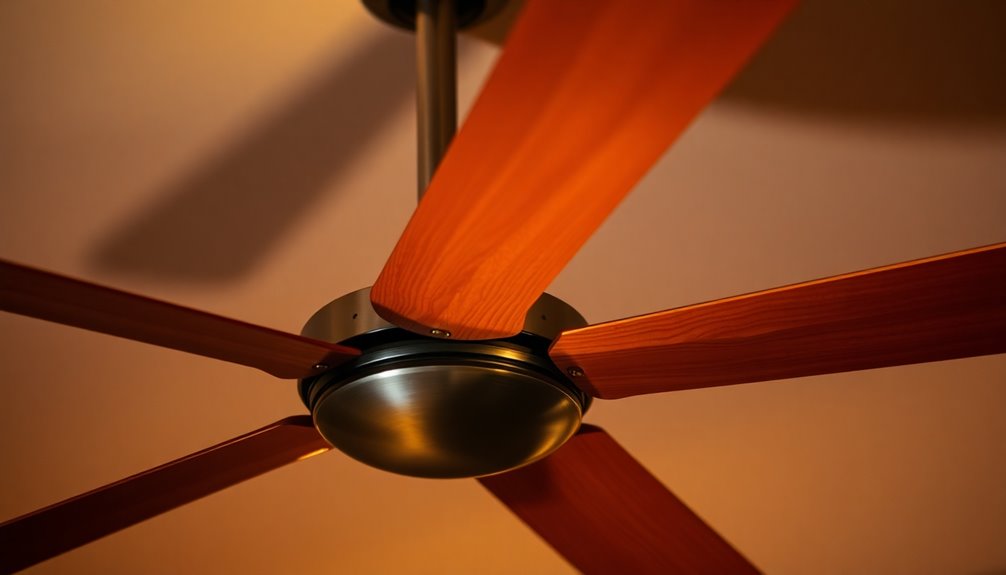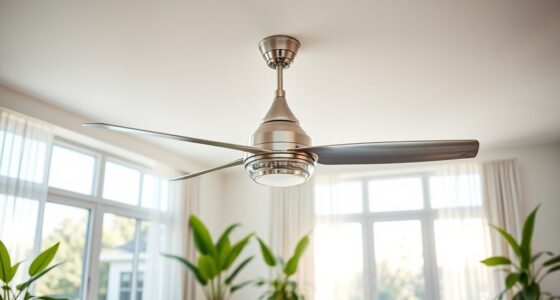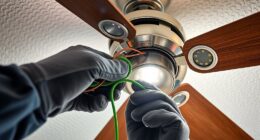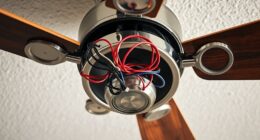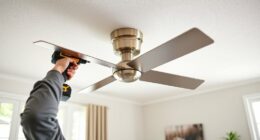Ceiling fans can be noisy for several reasons you might not consider. Loose screws and fasteners often cause rattling or clicking sounds. If the blades aren't balanced, you'll hear humming or vibrational noise. Worn motor bearings may create grinding or squeaking. Dust accumulation can also lead to disturbances in airflow, increasing noise levels. Electrical issues, like faulty wiring, result in buzzing sounds. Regular maintenance, such as tightening screws, cleaning blades, and lubricating bearings, can help reduce these noises. Want to learn more about specific fixes and when to call for help?
Key Takeaways
- Loose screws and fasteners can cause rattling or clicking noises due to misalignment and increased vibrations in the fan.
- Unbalanced blades lead to vibrations and humming sounds, which can be corrected using a balancing kit.
- Worn motor bearings may produce grinding or squeaking noises, indicating the need for lubrication and maintenance.
- Dust accumulation on blades and motor components disrupts airflow, resulting in increased noise levels during operation.
- Electrical issues, such as faulty wiring, can cause humming or buzzing sounds, requiring immediate inspection to prevent hazards.
Common Causes of Noise

When it comes to ceiling fans, several common causes can lead to unwanted noise in your home. One significant factor is loose screws, bolts, and fasteners. If you don't regularly tighten these, you might hear rattling or clicking noises while the fan operates.
Another issue arises from unbalanced blades; when the weight distribution is uneven or brackets misaligned, you'll likely experience vibrations that create a humming noise during use.
Additionally, worn-out or damaged motor bearings can generate grinding or squeaking sounds due to increased friction. To remedy this, you may need to lubricate or replace the bearings for smoother performance.
Dust accumulation is another culprit that disrupts airflow, causing increased noise levels. Regular cleaning is essential to maintain peak function and minimize disturbances.
Finally, electrical issues like faulty wiring or incompatible dimmer switches can lead to humming or buzzing noises. Addressing these problems promptly not only reduces noise but also prevents potential hazards.
Types of Ceiling Fan Noise

When you're dealing with a noisy ceiling fan, it's crucial to identify the type of noise you're hearing.
Different sounds, like clicking or humming, can point to specific issues that need your attention.
Understanding these noise types can help you troubleshoot and keep your fan running smoothly.
Common Noise Types
Ceiling fans can produce a variety of noises that often indicate underlying issues needing attention. Understanding these common noise types can help you identify potential problems and take action before they worsen. Here's a breakdown of the types of noises you might encounter:
| Noise Type | Description | Possible Causes |
|---|---|---|
| Humming or Buzzing | A low-frequency sound often linked to electrical issues. | Motor or wiring problems |
| Clicking Noise | A rhythmic sound that can be quite annoying. | Loose blades or bent arms |
| Rubbing Noise | A friction sound indicating misalignment or friction. | Insufficient lubrication |
| Rattling Noise | A loose sound that varies with speed and intensity. | Loose components or screws |
| Crackling/Sizzling | A serious noise that suggests potential electrical hazards. | Major wiring issues |
If you hear any of these noises, it's essential to investigate further. Ignoring them can lead to more significant problems down the line, so don't hesitate to address the issue to keep your ceiling fan running smoothly.
Causes of Noises
Understanding the common noise types can help pinpoint what's causing issues with your ceiling fan.
If you hear a clicking noise, it often points to loose parts or misaligned blades, leading to vibrations during operation. You'll want to check the screws and blade alignment to resolve this.
A hum or buzzing sound usually indicates electrical issues, such as a malfunctioning motor or faulty wiring, which require immediate attention. Ignoring these sounds may lead to more significant problems down the line.
If you notice any squeaking or grinding, it's typically due to worn-out bearings or lack of lubrication in the fan's moving parts. Regular maintenance can help eliminate these noises.
Moreover, rubbing noises often arise from misalignment, which can result from improper installation. Ensuring the fan is correctly mounted can minimize these sounds.
Lastly, crackling or sizzling noises shouldn't be ignored; they may signal serious electrical hazards that need urgent investigation to prevent fire risks.
Address these noise types promptly to maintain your ceiling fan's performance and safety.
Noise Identification Tips
Identifying the type of noise your ceiling fan makes can save you time and prevent further issues. Start by listening carefully to the sounds.
Clicking noises usually occur due to loose screws or bent blade arms; tightening these can often resolve the problem.
Humming or buzzing typically points to electrical issues, such as faulty wiring or a malfunctioning motor, so it's essential to investigate these promptly.
If you hear grinding or squeaking noises, this might indicate misalignment or lack of lubrication in the motor housing and mounting. Regular maintenance can help prevent these sounds.
Rattling noises often arise from loose screws or misaligned components; verify you check all parts regularly to avoid vibrations.
Lastly, crackling or sizzling sounds are serious and may suggest electrical hazards like short circuits. If you encounter these noises, it's best to contact a professional electrician immediately.
Loose Screws and Fasteners

When screws and fasteners in your ceiling fan become loose, they can create annoying rattling and clanking sounds that disrupt your peace. Loose screws in the blade brackets can lead to misalignment, causing increased vibrations and more noise during operation.
It's essential to guarantee these brackets are securely fastened to maintain a quiet environment.
Regular maintenance is key. A simple inspection of the motor assembly can help you identify and tighten any loose screws and bolts.
Don't forget about the canopy screws; if they're loose, they could rattle against the ceiling, adding to the unwanted noise.
Additionally, check the downrod connection to the ceiling. If it's not tight, you might experience wobbling and rattling sounds, which can stem from improper installation.
Unbalanced Fan Blades

Loose screws and fasteners aren't the only culprits behind a noisy ceiling fan; unbalanced fan blades can also create a racket. If the blades aren't evenly weighted, expect vibrations that lead to wobbling and annoying noise during operation. You should regularly inspect for loose screws or damaged parts, as these can contribute to imbalance.
Unbalanced fan blades often arise from improperly installed blades, warped designs, or even dirt accumulation. When one or more blades are coated with debris, the weight distribution gets thrown off, making the fan work harder and causing that dreaded noise.
Misaligned blade brackets can also alter the angles the blades cut through the air, further increasing instability and sound.
To tackle these issues, consider investing in a blade balancing kit. This tool helps you identify and correct balance problems, minimizing noise and enhancing performance. Proper installation of the blades at consistent heights is essential, so take the time to guarantee everything is set up right.
Motor and Bearing Issues

Motor and bearing issues can greatly contribute to the noise your ceiling fan makes. If you hear persistent humming or buzzing, it might be a sign of worn or damaged motor windings. This indicates potential failure within the motor itself, which you'll want to address promptly.
Additionally, dust accumulation on bearings can increase friction, leading to squeaking or grinding sounds during operation. Regular lubrication of motor bearings is essential for smooth operation. Without proper lubrication, noise issues can worsen, and the bearings may wear out prematurely.
You should also check for misaligned or loose motor components, as these can cause vibrations that amplify overall noise levels in your fan. Inspecting bearings for wear and tear is vital, since damaged bearings can considerably increase noise and may require replacement to restore quiet operation.
If you notice any unusual sounds from your ceiling fan, take the time to evaluate the motor and bearings. Addressing these issues early on will help keep your fan running quietly and efficiently. Don't ignore those noises—understanding motor and bearing issues is key to a peaceful home environment.
Maintenance Tips

Regularly maintaining your ceiling fan is vital to keeping it quiet and efficient. Start by tightening all screws and bolts, including those on the blade brackets and light fixtures. Loose components can cause annoying rattling and clicking noises.
Next, clean the fan blades and motor housing periodically to eliminate dust buildup. This buildup can disrupt performance and contribute to unwanted noise.
Don't forget to lubricate the motor bearings at least once a year. This step reduces friction and prevents grinding or squeaking sounds during operation.
Also, inspect the fan for signs of wear, such as warped blades or damaged components. Addressing these issues promptly is essential for maintaining quiet functionality.
Lastly, balance the fan blades using a balancing kit. Ensuring even weight distribution minimizes wobbling and associated noise.
Following these maintenance tips will extend the life of your ceiling fan while keeping it running smoothly and quietly. By dedicating a little time to these tasks, you'll enjoy a more peaceful environment and ideal airflow from your ceiling fan.
How to Identify Noise Sources

Even with proper maintenance, you might still notice some noise from your ceiling fan. To identify the noise sources, start by listening closely while the fan operates. Pay attention to specific sounds; this can help you pinpoint their locations.
Next, observe the movement of the blades. If you see them wobbling or shaking, it may indicate loose parts or an imbalance, which can lead to annoying noise.
Inspect the motor housing and the mounting bracket for any visible damage or misalignment. These issues can contribute to noise during operation. Additionally, check for dirt or debris accumulation on the blades and motor. This buildup can affect performance and create unwanted sounds as the fan spins.
Finally, test the fan at different speed settings. Sometimes, noise varies with speed, so adjusting the setting might help isolate the issue more effectively.
Fixing Noisy Ceiling Fans

When your ceiling fan starts making noise, it's essential to act quickly to restore peace and comfort in your space. To fix a noisy ceiling fan, first, identify the common causes.
Start by checking for loose components; verify all screws and bolts are tightly secured. Loose parts can lead to vibrations, causing rattling sounds.
If you hear humming or buzzing, inspect the motor for any overheating or defects. Also, check the electrical wiring for loose or damaged connections.
For rubbing noises, it may be due to misalignment. Adjust the fan blades' pitch or lubricate the motor bearings to eliminate this sound.
If wobbling is causing noise, balance the fan blades using a blade balancing kit. Inspect for any warping or damage that may require replacement.
Regular maintenance plays an important role in preventing many noise issues; clean the fan blades and lubricate the bearings periodically.
When to Call a Professional

If you're dealing with persistent noise from your ceiling fan despite your best efforts, it might be time to call in a professional.
Unusual sounds like grinding or buzzing can signal deeper mechanical or electrical issues that need expert evaluation.
Don't hesitate to reach out for help, especially if you notice any signs of electrical malfunction or visible damage.
Persistent Noise Issues
Persistent noise from your ceiling fan can be more than just an annoyance; it often signals underlying issues that need professional attention. If you notice your ceiling fan noisy despite routine maintenance, it's time to take into account the common causes. Unusual sounds like grinding or buzzing may suggest a malfunctioning capacitor or motor, which requires expert intervention. Ignoring these sounds can lead to further damage.
You should also be aware of signs of damage, such as cracked blades or a bent motor housing. These issues not only affect performance but can compromise safety, making a professional assessment crucial.
Additionally, if you experience flickering lights whenever the fan operates, this could indicate wiring problems that demand immediate electrical services from a licensed electrician.
If you've tried adjusting your fan but still face persistent noise issues, improper installation might be the culprit. In such cases, hiring a professional for remounting or correct installation can guarantee peak performance and peace of mind.
Don't hesitate to reach out for help when your ceiling fan's noise becomes a persistent problem; addressing it early can save you time and money down the road.
Complex Electrical Problems
Unresolved noise issues from your ceiling fan can often point to complex electrical problems that require professional expertise. If you notice persistent buzzing noises, it might indicate a malfunctioning capacitor or faulty wiring. In these cases, it's vital to contact a licensed electrician who can diagnose the issue safely.
You should also be aware that crackling or sizzling noises signal serious electrical hazards, necessitating immediate professional intervention to avert fire risks. Remote-controlled ceiling fans can also present challenges; weak receivers or faulty remotes may lead to noise. A licensed electrician can test the direct connections to resolve these issues effectively.
Lastly, if you've tried multiple maintenance attempts without success, it's time for an electrical inspection. Below is a quick reference table:
| Noise Type | Recommended Action |
|---|---|
| Buzzing Noises | Check for malfunctioning capacitor |
| Crackling/Sizzling | Immediate professional help |
| Remote Control Issues | Consult a licensed electrician |
| Incompatible Dimmers | Replace with appropriate controls |
| Persistent Issues | Schedule an electrical inspection |
In each case, seeking professional help guarantees your safety and the longevity of your ceiling fan.
Mechanical Component Failures
When your ceiling fan starts making unusual noises, it's time to dig deeper into potential mechanical component failures. Common noises like persistent humming or buzzing might signal a faulty fan motor or capacitor. If you notice these sounds, don't hesitate to seek a professional assessment to diagnose and replace these components before they lead to bigger problems.
Grinding or squeaking noises often indicate worn-out bearings. If lubrication doesn't fix the issue, a professional will likely need to replace the bearings to restore quiet operation.
Clicking or rattling sounds that persist, even after tightening screws, may suggest deeper mechanical issues that require expert intervention.
If your fan operates with unusual vibrations or wobbles despite your balancing efforts, it might be a sign of misalignment in the motor or bracket. This is another situation where calling a pro is essential for ensuring safety and functionality.
Additionally, keep an eye out for signs of electrical malfunction, such as flickering lights accompanying fan noise, which should prompt immediate professional help to prevent potential hazards.
Addressing these mechanical issues promptly can save you time, money, and safety concerns down the line.
Frequently Asked Questions
How Do I Stop My Ceiling Fan From Making Noise?
To stop your ceiling fan from making noise, start by tightening all screws and bolts to eliminate any rattling.
Clean the fan blades and motor housing to prevent dust buildup, which can disrupt balance.
Lubricate the motor bearings annually to reduce friction and avoid grinding sounds.
Consider using a balancing kit to guarantee even weight distribution, and inspect electrical connections for wear to address buzzing or humming noises.
How Do I Fix the Grinding Noise in My Ceiling Fan?
Imagine your ceiling fan as a car that's overdue for maintenance. To fix that grinding noise, start by checking for loose screws and bolts, tightening them if needed.
Next, clean the blades and motor housing to reduce dust buildup. Lubricate the motor bearings with the right oil annually to keep everything running smoothly.
If the noise continues, it might be time to call in a professional to assess potential motor issues.
Do Ceiling Fans Need to Be Oiled?
Yes, some ceiling fans need to be oiled, especially those with exposed motor bearings.
If your fan has this type of motor, check its manufacturer's specifications to see if it requires maintenance.
If it does, you can add a few drops of lightweight machine oil to reduce friction and noise.
Just remember to oil sparingly in the designated areas, as too much oil can attract dust and cause further issues.
Should I Be Worried if My Fan Is Making Noise?
If your ceiling fan's humming like a restless bee, it's time to pay attention.
You should definitely be worried if it's making unusual noises. These sounds might signal something's off—loose screws, unbalanced blades, or even electrical issues. Ignoring them could lead to bigger problems down the line.
Regular maintenance and a quick inspection can save you from potential hazards.
Conclusion
In the symphony of your home, a noisy ceiling fan can disrupt the harmony. By identifying the source of that unsettling hum or rattle, you can restore peace to your living space. Whether it's tightening loose screws or balancing blades, small adjustments can make a world of difference. Embrace the tranquil breeze once more, and let the gentle whirring of a well-maintained ceiling fan become the soothing backdrop to your everyday life.

